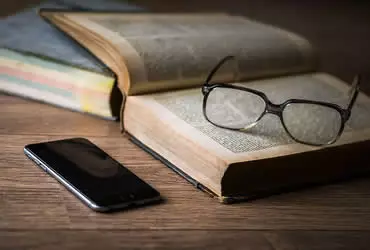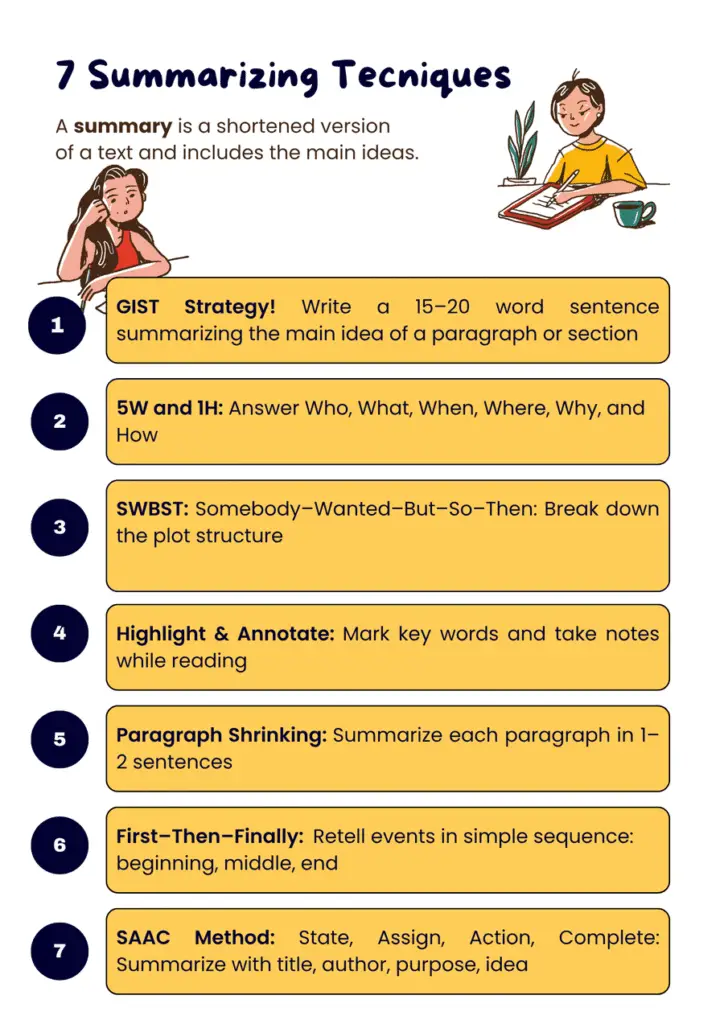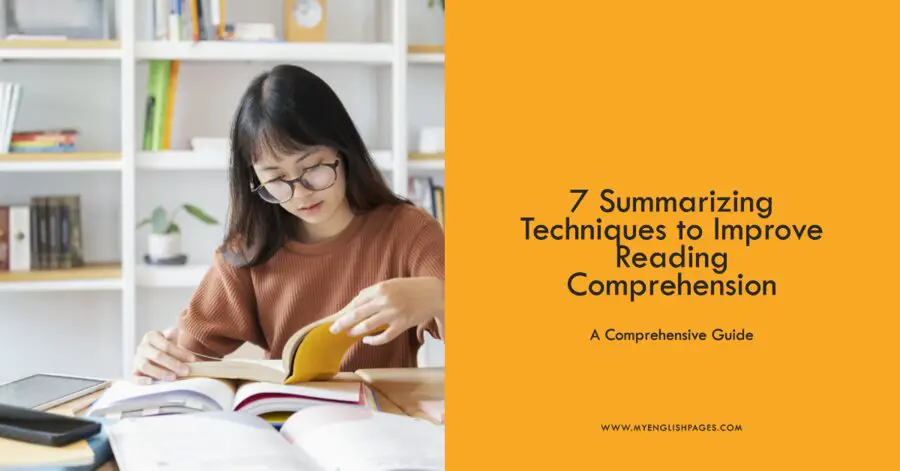Table of Contents
Summarizing is one of the most effective reading strategies for students and English learners. It allows readers to focus on the main ideas of a text, identify key points, and better retain the information they read. In this post, we’ll explore what summarizing is, why it matters, and five practical techniques you can use to improve reading comprehension.
What Is Summarizing?

Summarizing means expressing the essential ideas of a text in a shorter form — using your own words. It involves identifying the main idea and the most important details while leaving out less relevant information.
Summarizing is not just shortening; it’s about understanding. A good summary shows that you’ve grasped the key message and can communicate it clearly and briefly.
Why Is Summarizing Important in Reading?

Summarizing is a core reading strategy that offers several benefits:
- Helps readers focus on important information
- Boosts comprehension and retention
- Encourages active reading and critical thinking
- Prepares students for writing tasks, tests, or class discussions
- Supports language learning by reinforcing vocabulary and sentence structure
Summarizing can make students’ work more efficient and effective. It promotes active reading, whether they are managing heavy reading loads or, later on, handling complex information as professionals. More specifically, summarizing helps by:
- Saving time by focusing only on the essential points
- Reducing mental overload through clearer, simplified content
- Improving memory retention by reinforcing key ideas
- Speeding up decision-making by presenting the core message quickly
What Makes a Good Summary?
Before applying summarizing techniques, it’s important to understand the qualities of an effective summary. A good summary:
- Captures the main idea clearly and concisely
- Leaves out unnecessary or repetitive details
- Reflects the original meaning without copying it
- Avoids adding personal opinions or new information
- Is usually much shorter than the original text
Common Summarizing Mistakes to Avoid
To become a better reader and summarizer, avoid these typical mistakes:
- Including too many minor details
- Leaving out main points
- Copying and pasting exact sentences
- Writing a summary that’s too long
- Adding new ideas that weren’t in the original text
Now that we’ve seen what makes a strong summary — and what to avoid — let’s explore five proven techniques that will help you summarize more effectively and boost your reading comprehension.
7 Summarizing Techniques for Better Reading Comprehension
Below are seven summarizing techniques that are easy to use and highly effective, especially for students, ESL learners, and anyone aiming to become a more strategic reader.
1. The GIST Strategy
GIST stands for Generating Interactions between Schemata and Text. It’s a strategy where the reader writes a summary of around 15–20 words for each paragraph or section, capturing only the main idea.
How to do it:
- After reading a paragraph, ask yourself:
- What is the author mainly saying?
- Then write your answer in about 15–20 words, focusing only on the essential idea.
Example:
Paragraph to Read:
Photosynthesis is a vital process that takes place in the leaves of green plants. During this process, plants absorb sunlight using a pigment called chlorophyll. They then use this energy to convert carbon dioxide from the air and water from the soil into glucose, which serves as their food. Oxygen is released as a byproduct. This process is essential for plant growth and for maintaining the oxygen balance in the atmosphere.
GIST Summary (15–20 words):
Plants use sunlight, carbon dioxide, and water to make food through photosynthesis, releasing oxygen as a byproduct.
✅ Why it works: It trains your brain to focus on essential meaning and avoid unnecessary detail.
2. The 5W and 1H Technique
This technique is especially useful for summarizing informational texts like news articles or reports. You simply answer six key questions:
- Who?
- What?
- When?
- Where?
- Why?
- How?
Use the answers to construct a comprehensive yet concise summary.
Example:
On Monday morning, a fire broke out in the forests near Los Angeles. Firefighters responded quickly to emergency calls. They used Canadair jets to prevent the fire from spreading to nearby buildings. The fire was brought under control within two hours. Authorities are now investigating the cause of the blaze.
Summary using 5W and 1H:
- Who: Firefighters
- What: A fire broke out
- When: Monday morning
- Where: Forests near Los Angeles
- Why: The cause is under investigation
- How: They used Canadair jets to stop the fire from spreading
✅ Why it works: It ensures you cover the core elements without getting lost in extra detail.
3. Somebody–Wanted–But–So–Then (SWBST)
This technique is ideal for summarizing stories or narrative texts. It provides a clear structure by breaking the summary into parts:
Example:
- Somebody: Cinderella
- Wanted: to go to the ball
- But: her stepmother wouldn’t let her
- So: her fairy godmother helped her
- Then: she went to the ball and met the prince
✅ Why it works: It guides students in organizing story elements logically.
4. Highlighting and Annotating
This technique encourages active reading, helping you stay engaged with the text and better understand what you’re reading. By highlighting key words or phrases and adding brief notes, you’re not just reading passively — you’re interacting with the content. This makes it easier to review the main points later and construct an accurate summary.
How to do it:
- Highlight topic sentences or key terms
- Write brief annotations in the margin or on sticky notes
- Use symbols like ★ for main ideas or ? for questions/confusing parts
✅ Why it works: It turns reading into a more focused activity and gives you ready-made reference points when writing your summary.
5. Paragraph Shrinking
Paragraph Shrinking is a simple but powerful reading strategy that helps readers identify the main idea and key details of a paragraph. By stopping after each paragraph and summarizing it in one or two sentences, you train yourself to focus on the most important information. This makes it easier to understand, remember, and eventually summarize the entire text.
How to do it:
After reading a paragraph, ask yourself:
- What is the paragraph mostly about?
- What are the most important details?
- Can I say this in a simpler way?
Example Paragraph:
The water cycle is the continuous movement of water on, above, and below the surface of the Earth. It begins when the sun heats up water in rivers, lakes, or oceans, causing it to evaporate and rise into the air. As the water vapor cools, it condenses into clouds. Eventually, it falls back to the ground as precipitation, such as rain or snow, and the cycle starts again.
Paragraph Shrinking Summary:
The water cycle describes how water moves through evaporation, condensation, and precipitation in a continuous loop.
✅ Why it works: This technique builds confidence by allowing students to summarize texts one step at a time. It’s especially helpful for learners who feel overwhelmed by longer texts.
6. First–Then–Finally
The First–Then–Finally technique is a straightforward reading comprehension strategy that helps readers organize and retell events or ideas from a text in a logical sequence. It’s especially useful for summarizing narrative texts, short stories, or any passage that follows a clear order of events.
By identifying what happened first, what happened next, and how it ended (finally), learners can create a concise summary that captures the structure of the original passage.
How to do it:
After reading a short text, ask yourself:
- First: What happened at the beginning?
- Then: What happened next?
- Finally: How did it end?
Example Paragraph:
Yesterday, Mia decided to bake cookies. First, she gathered all the ingredients from the kitchen. Then, she mixed them together and shaped the dough into small circles. Finally, she placed them in the oven and waited patiently until the cookies were golden brown and ready to eat.
First–Then–Finally Summary:
- First: Mia gathered all the ingredients.
- Then: She mixed and shaped the dough.
- Finally: She baked the cookies and waited until they were ready.
✅ Why it works: This technique simplifies the summarizing process by focusing on sequence, making it easier for learners to organize their thoughts and recall events clearly.
7. SAAC Method (State, Assign, Action, Complete)
The SAAC method is a structured reading comprehension strategy that guides readers through the process of writing a strong summary sentence. It is especially effective for summarizing non-fiction texts, textbook passages, or short articles because it focuses on identifying the subject, the author, and the main action or idea.
SAAC stands for:
- State the name of the article or text
- Assign the name of the author
- Action – describe what the author is doing (explaining, describing, showing…)
- Complete the sentence with the main idea
How to do it:
- After reading a short informational text, follow this sentence frame:
- → In “[Title],” [Author] [action verb] that [main idea]
Example SAAC Summary:
In “Why Bees Matter,” Julia Green explains that bees are essential for pollination and their decline threatens food supply and ecosystems.
✅ Why it works: This technique gives students a clear structure to follow and ensures that their summary includes all the critical components: source, author, purpose, and main idea. It’s especially useful for academic reading.
Summary Table: 7 Summarizing Techniques for Reading Comprehension
| Technique | Description | Best For | Why It Works |
|---|---|---|---|
| 1. GIST Strategy | Write a 15–20 word sentence summarizing the main idea of a paragraph or section | Any type of text | Focuses on core meaning and filters out details |
| 2. 5W and 1H | Answer Who, What, When, Where, Why, and How | Non-fiction, news, reports | Ensures key facts are identified in a logical format |
| 3. SWBST | Somebody–Wanted–But–So–Then: Break down the plot structure | Narrative and story-based texts | Helps organize story elements for easy summary writing |
| 4. Highlight & Annotate | Mark key words and take notes while reading | Any reading (especially academic or long texts) | Encourages active reading and provides cues for later summarizing |
| 5. Paragraph Shrinking | Summarize each paragraph in 1–2 sentences | Any paragraph-heavy text | Builds summarizing skill one step at a time |
| 6. First–Then–Finally | Retell events in simple sequence: beginning, middle, end | Young readers, ESL learners, short stories | Simplifies structure and improves sequencing |
| 7. SAAC Method | State, Assign, Action, Complete: Summarize with title, author, purpose, idea | Articles and non-fiction texts | Encourages structured, academic summary writing |
Bonus Tip: Use Graphic Organizers
Visual aids like main idea charts, story maps, or summary frames help students break down and organize information before writing a summary.
🧾 You can download or create simple templates to support classroom or self-study use from canva.com.

Conclusion
Summarizing is a valuable reading skill that helps learners understand and remember what they read. The seven summarizing techniques above will help students become more focused and effective readers, whether they’re studying for a test, preparing to write, or just trying to make sense of a complex text.
Try different techniques and choose the one that works best for your reading style!


